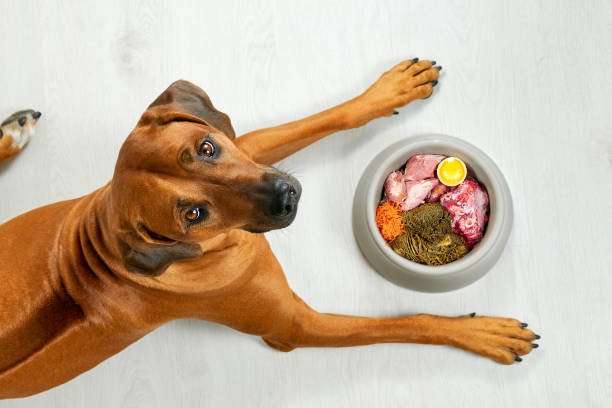In recent years, the trend of making homemade dog food has grown as pet owners seek to provide their dogs with healthier, more natural diets. However, it’s essential to ensure these meals are nutritionally balanced to avoid potential health risks. Balanced homemade dog food recipes are crucial for meeting your dog’s dietary needs, supporting their overall health, and preventing issues that can arise from nutrient deficiencies or excesses. In this article, we’ll explore the importance of balanced nutrition and offer practical solutions to create homemade meals that keep your dog healthy and happy.
 Why is Balanced Nutrition Crucial for Dogs?
Why is Balanced Nutrition Crucial for Dogs?
Understanding Essential Nutrients
Ensuring your dog receives a balanced diet is vital for their overall health and well-being. Like humans, dogs need a balanced mix of essential nutrients to stay healthy and thrive. Proteins are crucial for muscle growth and repair, fats provide energy and support brain health, while carbohydrates offer a quick energy source. Vitamins and minerals are equally important, playing roles in everything from immune function to bone health.
The Importance of the Calcium-to-Phosphorus Ratio
One often overlooked aspect in homemade dog food recipes is the Calcium-to-Phosphorus Ratio. This ratio is essential for maintaining strong bones and teeth. An imbalance may result in bone disorders or other health complications. Ensuring this ratio is correct helps to prevent such problems and supports your dog’s skeletal health.
Crafting Balanced Homemade Dog Food
When preparing homemade dog food, it’s important to include the right mix of these nutrients. Recipes that neglect this balance can lead to long-term health problems. It’s essential to understand and meet your dog’s nutritional needs. This article will guide you in creating balanced meals that meet your dog’s dietary requirements, helping them live a longer, healthier life.
5 Easy and Balanced Homemade Dog Food Recipes
1. Classic Chicken and Rice
This is a gentle recipe, perfect for dogs with sensitive stomachs.
 Ingredients:
Ingredients:
- 1 pound lean ground chicken
- 1 cup brown rice
- 1 cup mixed vegetables (carrots, peas, green beans)
- 1/4 cup plain Greek yogurt
- 1 tablespoon olive oil
Instructions:
Cook chicken and rice separately.
Sauté vegetables lightly.
Combine all ingredients and let cool.
2. Beef and Sweet Potato Delight
A tasty and nutritious option for most dogs.
Ingredients:
- 1 pound lean ground beef
- 1 sweet potato, baked and mashed
- 1/2 cup green beans, cooked
- 1 egg, scrambled
- 1 tablespoon flaxseed oil
Instructions:
Brown beef, then drain excess fat.
Combine with mashed sweet potato, green beans, and scrambled egg.
Stir in flaxseed oil for omega-3 fatty acids.
3. Salmon and Quinoa Power
A grain-free option packed with omega-3s.
Ingredients:
- 1 pound salmon, cooked and flaked
- 1 cup quinoa, cooked
- 1/2 cup spinach, chopped
- 1/4 cup pumpkin puree
- 1 teaspoon coconut oil
Instructions:
Combine all ingredients and mix well.
4. Turkey and Veggie Medley
A versatile recipe that can be adjusted based on your dog’s preferences.
Ingredients:
- 1 pound lean ground turkey
- 1 cup brown rice or quinoa
- 1 cup mixed vegetables (carrots, broccoli, zucchini)
- 1/4 cup plain Greek yogurt
- 1 teaspoon apple cider vinegar
Instructions:
Cook turkey and grains separately.
Sauté vegetables.
Combine all ingredients, including apple cider vinegar for digestive health.
5. Beef Liver and Oatmeal Boost
A nutrient-rich option, but feed in moderation due to high iron content.
Ingredients:
- 1/2 pound beef liver, cooked and ground
- 1 cup oatmeal, cooked
- 1/2 cup carrots, grated
- 1 tablespoon coconut oil
Instructions:
Combine all ingredients and mix well.
Common Mistakes in Homemade Dog Food Recipes
Overlooking Nutrient Balance
Homemade dog food can be a great way to ensure your pet is eating fresh, natural ingredients, but it’s easy to make mistakes that could harm your dog’s health. A frequent mistake is failing to ensure proper nutrient balance. Many popular recipes focus too heavily on proteins or carbohydrates while neglecting essential vitamins and minerals. This imbalance can lead to health problems like poor coat condition, weakened immune system, or even serious issues like heart disease.
The Importance of Supplements in Homemade Dog Food
To avoid these risks, it’s important to consider adding supplements to your dog’s diet. Fish oil is an excellent source of omega-3 fatty acids, which support brain and heart health. Calcium is vital for strong bones, and multivitamins can help fill any nutritional gaps in your dog’s diet. These supplements are often overlooked in homemade dog food guides, but they are crucial for maintaining your dog’s overall well-being.
Ingredient Safety: Avoiding Harmful Foods for Dogs
Another critical point is ingredient safety. Some ingredients that are safe for humans can actually be harmful or toxic to dogs. For example, garlic and onions, common in many home-cooked meals, can cause serious health problems in dogs, including damage to red blood cells. Always research and ensure that the ingredients you’re using are safe for your pet.
How to Create Balanced Homemade Dog Food Recipes
Essential Components of a Balanced Recipe
Creating a balanced homemade dog food recipe requires including several key components. Start with high-quality protein sources such as chicken, beef, or fish. Proteins play a crucial role in building muscle and maintaining overall health. Include vegetables such as carrots, peas, and spinach to provide essential vitamins and minerals. Grains like brown rice or oats can provide necessary carbohydrates and fiber.
Crafting Your Own Balanced Homemade Dog Food Recipes
Many homemade dog food recipes overlook the need for supplements. To fill nutritional gaps, consider adding supplements like fish oil, which provides essential omega-3 fatty acids for a healthy coat and brain function. Calcium supplements are crucial for bone health, especially if you’re not using bone meal in your recipes. Multivitamins can help ensure your dog gets all the necessary nutrients. These additions are often missed in other guides but are essential for a complete diet.
Portion Control and Serving Sizes
Determining the correct portion sizes is essential for maintaining a balanced diet. Determining the correct portion sizes is essential for maintaining a balanced diet.
The amount of food your dog needs depends on their age, breed, size, and activity level. Puppies and active dogs may require more food compared to older or less active dogs. Use a dog food calculator or consult with your vet to find the right serving sizes and adjust portions as needed to prevent overfeeding or underfeeding.
Sample Nutritious Homemade Dog Food Recipes
Balanced Recipes for Different Life Stages
When preparing homemade dog food, it’s important to tailor recipes to your dog’s life stage. Here are some examples:
- Puppy Recipe: Combine lean ground chicken, sweet potatoes, carrots, and peas. Puppies need more protein and energy to support their rapid growth. This recipe provides essential proteins, vitamins, and minerals.
- Adult Dog Recipe: Mix beef, brown rice, spinach, and green beans. Adult dogs need a well-balanced blend of protein, carbohydrates, and fiber to sustain their health and energy levels.
- Senior Dog Recipe: Use turkey, quinoa, pumpkin, and blueberries. Senior dogs benefit from lower fat content and additional antioxidants to support aging joints and cognitive function.
Nutritional Analysis and Recipe Rotation
Each recipe includes a nutritional analysis to ensure it meets the specific needs of each life stage. For example, the puppy recipe is high in protein and calcium, essential for growing bones and muscles, while the senior recipe includes ingredients that support joint health and digestion.
Recipe Rotation is crucial to avoid nutrient imbalances. Rotating recipes ensures your dog gets a variety of nutrients over time, preventing deficiencies or excesses. It’s a practical approach often missed in other guides.
Special Dietary Needs
For dogs with specific dietary needs, consider these options:
- Grain-Free Recipe: Combine salmon, sweet potatoes, and broccoli. Grain-free diets are suitable for dogs with allergies or sensitivities to grains.
- Hypoallergenic Recipe: Use lamb, peas, and carrots. This recipe avoids common allergens like beef and chicken, making it ideal for dogs with food sensitivities.
How to Ensure Your Dog’s Diet Remains Balanced Over Time
Regular Vet Check-Ups
To keep your dog’s diet balanced and ensure their ongoing health, regular vet check-ups are essential. Schedule visits with your veterinarian at least once a year, or more frequently if your dog has specific health concerns. During these check-ups, your vet can assess your dog’s overall health, monitor their weight, and evaluate their nutritional needs. They can also provide personalized advice on adjusting their diet based on changes in their health, activity level, or age. Regular consultations help prevent potential health issues and keep your dog’s diet on track.
Recipe Rotation for Nutritional Variety
Recipe Rotation is a key practice for maintaining a balanced diet. By rotating homemade dog food recipes, you can ensure your dog receives a diverse range of nutrients and prevent nutrient imbalances. Different recipes provide various vitamins, minerals, and other nutrients that may not be present in a single recipe. This approach helps avoid deficiencies or excesses that can occur when feeding the same meal repeatedly.
Many guides overlook the importance of recipe rotation, but it is crucial for long-term health. Incorporating a variety of recipes into your dog’s diet not only keeps mealtimes interesting but also supports overall well-being. By regularly changing recipes, you provide your dog with a more balanced intake of nutrients and contribute to their long-term health.
Conclusion
Creating balanced homemade dog food recipes is crucial for your dog’s health and well-being. By incorporating the right mix of proteins, fats, carbohydrates, vitamins, and minerals, you can support your pet’s growth, energy, and overall health. Key aspects like the Calcium-to-Phosphorus Ratio and necessary supplements should be addressed to avoid nutritional gaps. Regular vet check-ups and recipe rotation are essential to ensure the diet remains balanced, preventing nutrient deficiencies over time. With careful planning and ongoing monitoring, you can craft homemade dog food that truly benefits your dog’s health and happiness.
FAQs
How do I know if my dog’s diet is balanced?
To determine if your dog’s diet is balanced, check if the homemade dog food recipes you’re using meet all of their nutritional needs. A balanced diet should include the right mix of proteins, fats, carbohydrates, vitamins, and minerals. Regular vet check-ups are crucial as your veterinarian can evaluate your dog’s overall health and dietary needs. They can help assess if the balanced homemade dog food recipes you’re using are providing complete nutrition or if adjustments are necessary.
Can I substitute ingredients in homemade dog food recipes?
Yes, you can substitute ingredients in homemade dog food recipes, but it’s important to ensure that the substitutes maintain the recipe’s nutritional balance. For example, if your dog is allergic to chicken, you might substitute it with turkey or beef. However, make sure the replacement ingredient provides similar nutritional benefits. For any substitutions, consider consulting with your vet or a pet nutritionist to ensure that your adjusted recipe remains balanced and meets all of your dog’s dietary needs.
How often should I rotate homemade dog food recipes?
Rotating homemade dog food recipes is important to provide nutritional variety and prevent deficiencies. A good rule of thumb is to change recipes every 3 to 4 weeks. This ensures your dog gets a range of nutrients from different ingredients, which can help prevent nutrient imbalances. Consistent recipe rotation also keeps your dog’s meals interesting and supports overall health.
What are the key supplements to include in homemade dog food recipes?
Some key supplements to consider include fish oil, which provides omega-3 fatty acids for a healthy coat and brain function, and calcium to support strong bones. Multivitamins can help cover any nutritional gaps. Many high-authority guides overlook the importance of these supplements, but they are crucial for ensuring your homemade dog food recipes are fully balanced.
Are there any common ingredients I should avoid in homemade dog food recipes?
Yes, some ingredients are harmful to dogs and should be avoided. Common toxic ingredients include garlic, onions, chocolate, and grapes. Ensure that all ingredients in your balanced homemade dog food recipes are safe for dogs and consult a vet or pet nutritionist if you’re unsure about any specific ingredient.


 Why is Balanced Nutrition Crucial for Dogs?
Why is Balanced Nutrition Crucial for Dogs?









